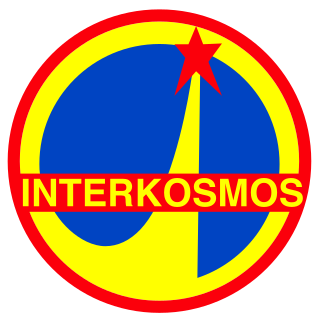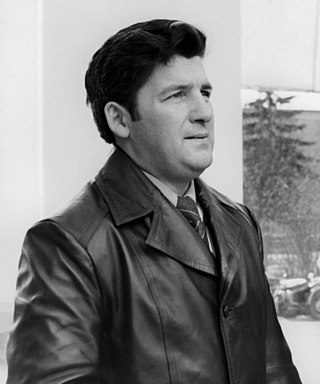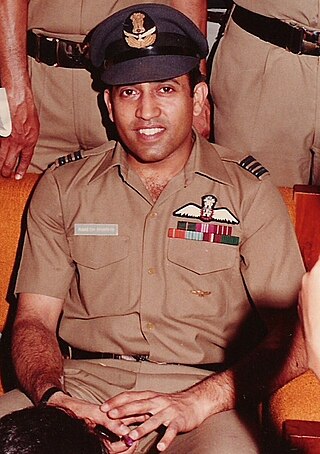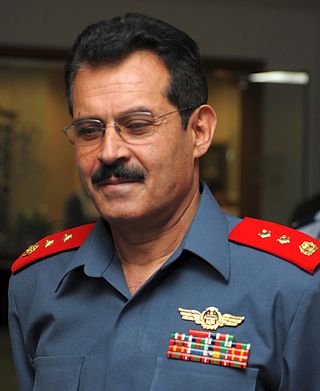
Valery Fyodorovich Bykovsky was a Soviet cosmonaut who flew on three space flights: Vostok 5, Soyuz 22, and Soyuz 31. He was also backup for Vostok 3 and Soyuz 37.

Interkosmos was a Soviet space program, designed to help the Soviet Union's allies with crewed and uncrewed space missions.

Pyotr Ilyich Klimuk is a former Soviet cosmonaut and the first Belarusian to perform space travel. Klimuk made three flights into space. From 1991 to 2003, he headed the Yuri Gagarin Cosmonaut Training Center.

Wing Commander Rakesh Sharma, AC is an Indian astronaut and a former Indian Air Force officer. He flew aboard Soyuz T-11 on 3 April 1984 as part of the Soviet Interkosmos programme. He is the only Indian citizen to travel in space, although there have been other astronauts of Indian origin who travelled to space, who were not Indian citizens. Another Air Force pilot, Ravish Malhotra, was placed on standby.

The Indian Air Force (IAF) is the air arm of the Indian Armed Forces. Its primary mission is to secure Indian airspace and to conduct aerial warfare during armed conflicts. It was officially established on 8 October 1932 as an auxiliary air force of the British Empire which honoured India's aviation service during World War II with the prefix Royal. After India gained independence from United Kingdom in 1947, the name Royal Indian Air Force was kept and served in the name of the Dominion of India. With the transition to a republic in 1950, the prefix Royal was removed.
Abdul Ahad Momand is an Afghan-German and former Afghan Air Force aviator who became the first, and currently only, Afghan astronaut to journey to outer space. He became one of Soyuz TM-6 crew members and spent nine days aboard the Mir space station in 1988 as an Interkosmos research cosmonaut.
Nehru Planetariums are the five planetariums in India, named after India's first Prime Minister, Jawaharlal Nehru. These are located in Mumbai, New Delhi, Pune and Bangalore, plus there is a Jawahar Planetarium in Allahabad, where Jawaharlal Nehru was born.

Arnaldo Tamayo Méndez is a Cuban military officer, legislator, and former cosmonaut and the first person of African heritage in space. In 1980, as a member of the crew of Soyuz 38, he became the first Cuban citizen, the first Latin American, the first person of African descent, and the first person from a country in the Western Hemisphere other than the United States to travel into Earth orbit.

Major general Georgi Ivanov Kakalov is a Bulgarian former military officer who was the first Bulgarian cosmonaut. He was a member of the National Assembly of Bulgaria in 1990.
Soyuz 35 was a 1980 Soviet crewed space flight to the Salyut 6 space station. It was the 10th mission to and eighth successful docking at the orbiting facility. The Soyuz 35 crew were the fourth long-duration crew to man the space station.

Soyuz T-11 was the sixth expedition to the Soviet Salyut 7 space station, which in 1984 carried the first Indian cosmonaut along with Soviet crew members.

Dumitru Dediu was a pilot in the Romanian Air Force and cosmonaut candidate that was assigned as the backup for Dumitru Prunariu.

The Human Rated Launch Vehicle is an ongoing programme by the Indian Space Research Organisation (ISRO) to develop the technology needed to launch crewed orbital spacecraft into low Earth orbit. Three uncrewed flights, named Gaganyaan-1, Gaganyaan-2 and Gaganyaan-3 are scheduled to launch in 2024, followed by crewed flight in 2024 on an HLVM3 rocket.
The Bulgarian cosmonaut program refers to human spaceflight efforts by the People's Republic of Bulgaria. The idea of a Bulgarian crewed space mission predated the launch of Sputnik 1, the first artificial satellite. An informal proposal for the Soviet Union to send a Bulgarian cosmonaut in space was issued in 1964, but it was not seriously considered by the Soviets. Official space cooperation began in 1966 with the establishment of the Interkosmos programme which allowed Communist Bloc countries to access Soviet space technology and assets.

St Thomas' School is a co-educational kindergarten to higher secondary school in Kidderpore, Kolkata, West Bengal, India. It was established on 21 December 1789, making it one of the oldest schools in India and has the largest campus in Kolkata. The school is affiliated to the Council for the Indian School Certificate Examinations (ISC), which conducts the ICSE and ISC examinations over the country.
Thekkethil Kochandy Alex is an Indian space scientist. He was the director of the ISRO Satellite Centre (ISAC) of Indian Space Research Organisation (ISRO) (2008–2012) and Member, Space Commission. He specialized in electro-optic systems and satellite technology. Starting with the first Indian satellite Aryabhata, he has been responsible for the sensor systems in all the Indian satellites. Under his leadership the Laboratory for Electro Optics Systems (LEOS) was established in 1993 and from the inception he was its director till 2008. He was conferred "Dr. Vikram Sarabhai Distinguished Professorship" in 2011.

Major General Mohammad Dawran is an Afghan former military officer as well as the former Commander of the Afghan Air Force, enlisting in 1973. He was promoted to the post in 2005 by Defense Minister Abdul Rahim Wardak and the Commander-in-Chief Bismillah Khan Mohammadi. His permanent post was in Bagram Air Base, the largest air base in Afghanistan and one of the largest air bases in the region. The new commander of the Afghan Air Force, Amanuddin Mansoor, was appointed in December 2021.

Jean-Loup Jacques Marie Chrétien is a French retired Général de Brigade in the Armée de l'Air, and a former CNES spationaut. He flew on two Franco-Soviet space missions and a NASA Space Shuttle mission. Chrétien was the first Frenchman and the first western European in space.

The Indian Air Force Test Pilot School is a unit of the Indian Air Force (IAF) that evaluates aircraft and systems for induction into user organisations. Most new aircraft types and major airborne systems must have ASTE's stamp of approval to be considered fit for service in India. While many countries have testing facilities of one kind or the other, training of flight test personnel is not often imparted in them. ASTE's Air Force Test Pilots School (AFTPS) is only the fifth such institution in the world.

















